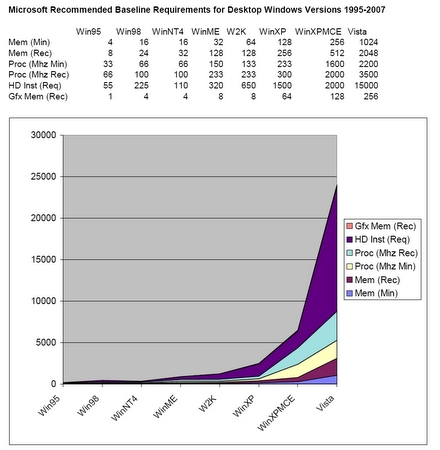Windows: Time to Go on a Diet

Microsoft Windows needs a diet.
Obesity seems to be a pretty universal theme in our culture today. We’re eating too many fatty and sugar-laced foods and our waistlines – and our health – are suffering as a collective result. I’ve even heard many doctors and dieticians describe the obesity and diabetes problem as an epidemic. We’re not bothering to step on the scale from week to week and looking at product labels and watching how this lifestyle is affecting our health. On a personal level, I finally decided to stop the insanity last year, and went on a mission to eat healthier and lose weight. Since October of 2007, I’ve already lost 45 pounds. I’ve still got a long ways to go, but I’m feeling much more sprightly and energetic for it, and my doctor is very pleased with my bloodwork and vitals. You’d be surprised what eliminating High Fructose Corn Syrup (HFCS) and other processed sugars, eating whole grains, eating more veggies, and introducing tofu and other low-fat proteins into your diet can do for you, along with walking and regular exercise.
I wish, however, I could say the same thing for Windows. If last week’s 165-page email debacle could be boiled down to anything, is that Microsoft’s 10-year hardware eating binge has finally caught up to it. With every Windows release, we’ve seen a geometric increase in the amount of hardware required to support good performance of the OS and greatly added software complexity with questionable improvement in actual usability and base functionality. This in turn has led to vastly increased total cost of ownership in the x86 WinTel platform for both consumers and the enterprise. Just how much bloat the PC platform has had to balloon itself to support consecutive releases of Windows for the past 10 years has been utterly staggering, if you look at the raw numbers.

Before the RTM of Windows Vista release in January of 2007 I started work on a small spreadsheet called the “Windows Hardware Requirement Envelope” (link: Adobe PDF file), which I pet named the “Winbloatagraph”. This is simply a chart of minimum and recommended hardware requirements for desktop versions of Windows, from 1995 to 2007.
I haven’t bothered to dust it off and tweak it for Vista SP1, or to break it down or extract similar charts for “corporate” versions or the server derivatives. I based the data on this chart from information gleaned from Microsoft’s web site at the time, and from practical experience as a systems integrator over the course of my professional work supporting desktop systems in large corporate environments. I think someone who had access to the official specs could probably make a more accurate assessment, and it would also be interesting to see the difference between consumer versions, corporate versions, and server versions, and their relative impact on things like hardware cost, software cost, support costs and infrastructure costs, but I believe the end result is the same – the WinTel platform is out of control.
Combine this with a slowing economy and the overall corporate desire to reduce desktop support cost, increase density in the datacenter, and the push towards virtualization of commoditized/utility computing infrastructure (as well as desktop virtualization) and renewed interest in Mainframes and mainframe-derived technology such as water-cooled datacenters, this should serve as a big warning sign for the folks at Redmond.
I haven’t bothered to put together a “Winbloatagraph” equivalent for Linux versions, but I suspect that that numbers would be dramatically different.
How is your enterprise combating Windows bloat? I’d like to hear your feedback.